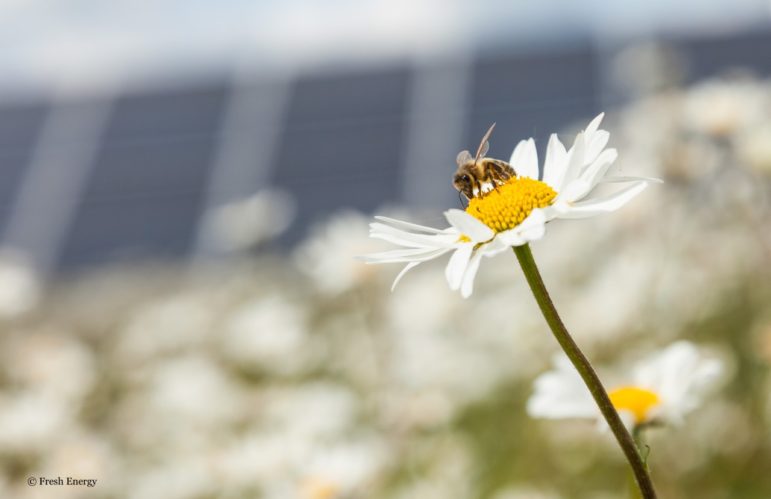
When planning for a pollinator-friendly solar array, use the following best practices.
- Ensure your general contractor uses an experienced vendor for the vegetation design, installation, and management. The partner hired should have demonstrated expertise in establishing and managing meadows.
- In engineering design, the bottom edge of the panels should be at least 30 inches from the ground and electrical cables and conduit should be buried. For an approximate one-time cost of only $3000 per megawatt per additional foot due to additional steel, having PV panels near waist-height allows for lower-cost seed mixtures and better vegetation establishment while reducing risk of mower-solar collisions. Above-ground cables in a PV solar array block the rows resulting in a significant increase in string-trimming and mowing costs for the life of the asset.
Webinars by category
- Zoning and planning
- State Pollinator-Friendly Solar Initiatives
Host: Clean Energy States Alliance - Pollinator-Friendly Solar: Setting State Standards
Host: Energy Resource Center at the University of Illinois, Chicago. - NREL Webinar: Co-locating Agriculture and Solar
Hosts: U.S. Department of Energy and National Renewable Energy Laboratory
Presenters: Center for Pollinators in Energy, National Renewable Energy Laboratory, and SoCore Energy - Planning and Zoning Best Practices for Large Scale Solar Developments
Host: GoSolSmart
- State Pollinator-Friendly Solar Initiatives
- “How To” for solar industry professionals
- Pollinator-Friendly Solar: Overview & Technical Practicum
Hosts: North Carolina Clean Energy Technology Center and Audubon North Carolina
Presenters: Center for Pollinators in Energy, National Renewable Energy Laboratory, Perdue Farms, SoCore Energy, Cypress Creek Renewables, and Prairie Restorations, Inc.
- Agrivolatics: Harvesting multiple benefits from solar sites
Host: Yale School of Forestry & Environmental Studies
Presenters: Center for Pollinators in Energy, Clif Bar, NREL, and Engie. - Clean Capital Podcast – Experts Only
Host: Jon Powers, Founder of CleanCapital, whose Experts Only podcast explores the intersection of energy, innovation and finance. Jon speaks with Rob Davis of Fresh Energy to discuss the link between pollinator insects and solar energy. - Monarch Joint Venture: Solar and Pollinators
Host: U.S. Department of Interior National Conservation Training Center
Presenters: Center for Pollinators in Energy, Monarch Joint Venture, and OneEnergy Renewables
- Pollinator-Friendly Solar: Overview & Technical Practicum
- Corporate procurement
- Corporate Leadership on Solar Arrays with Abundant Pollinator Habitat
Host: International Society of Sustainability Professionals
Presenters: Center for Pollinators in Energy, Perdue Farms, and Gund Institute for Ecological Economics
- Corporate Leadership on Solar Arrays with Abundant Pollinator Habitat
Apiaries
- If you’re planning to host beehives outside the fence of your solar project, be sure to consult our Best Practices for Solar Farm Apiaries.
Grazing
- When done right, grazing solar farms with sheep can benefit soils, biodiversity, and farmers/ranchers. However, when best practices aren’t used, continuously grazing sheep can damage the panels, chew on wires, and attract predators. Consult with the American Solar Grazing Association for best practices in rotational grazing of sheep on solar farms.

